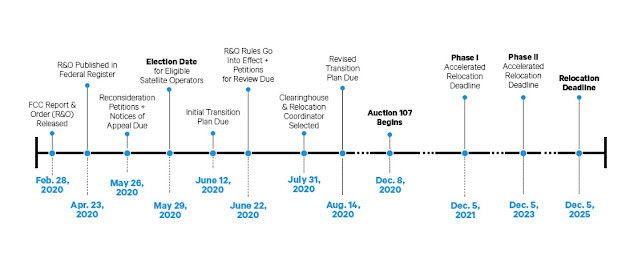Back in 2020, the Federal Communications Commission began the process of carving some C-Band spectrum away from Satellite service providers and turning it into spectrum for ground-based 5G network services. The plan was to clear 280 MHz of C-band spectrum (plus a 20-MHz guard band) for 5G mobile services in the contiguous United States (CONUS) as early as December 2023, with a portion of that spectrum becoming available as early as December 2021. The frequencies chosen were in the range of 3.7 to 3.98GHz; and I assume the 20 MHz guard band are 10 MHz farther away on either end or 3.69 to 3.99 GHz.
Since this spectrum was allocated to satellite downlinks, with the majority of
it originally things like satellite TV downlinks, they devised a plan to award bonuses to
the satellite companies that could comply soonest to specific dates to
accomplish their "C-Band Clearing".
On this chart, those dates are the Phase I and Phase II Accelerated Relocation Deadlines of
December 5, 2021 and the same calendar date in 2023. The process is supposed to be finished two years after that, December 5, 2025.
We learned today that industry giant Intelsat has met the conditions for a $3.7 billion award this coming December for meeting the Phase II deadline. The bonuses come from the $81 billion that the FCC collected auctioning off that spectrum; in essence, the mobile service (mobile phone) companies paid that money to the satellite companies through the FCC middleman. Intelsat also received a smaller award, $1.2 billion, at the Phase 1 deadline in 2021.
Weeks after launching its seventh and final C-band clearing satellite, the company said it had achieved certification for work to move broadcast customers into a narrower swath of the spectrum.
The FCC is also reimbursing Satellite providers that had to replace geostationary satellites to clear the spectrum. While Intelsat was able to move C-band services between their existing satellites, they were all approaching the end of their operational lives during the transition plan. SpaceNews reports Intelsat’s recently launched Galaxy-37 C-band replacement satellite is slated to come online later this year to replace Galaxy-13.
Tom McNamara, senior vice president of commercial programs at Intelsat, who led its C-band clearing project, said the company finished clearing the frequencies and protecting ground earth stations from interfering with telcos in June.
The company officially certified its clearing work July 12, which the FCC automatically validated Aug. 11 after 30 days without a challenge.
Intelsat ordered six C-band replacement satellites in 2020: Two from Northrop Grumman and four — including Galaxy 31 and Galaxy 32 shown here — from Maxar. Photo credit: Maxar
I've written about 5G a few times, mostly a few years ago when it was "the new hotness," and I worked in the satellite TV business, from the early '80s when it was largely C-band through the dawn of the Ku band, small-dish, satellite TV world. I was amazed at how out of touch I was with this development. I still get trade magazines (which are harder to drop than you might think) but this was all news to me.
The trade magazines tend to be talking about 6G now and not much about 5G. I'm not aware of any 5G provider that went to highest frequencies talked about back in the 2019 time frame (24 GHz) nor any chip makers advertising 24 GHz systems. That said, I don't think my not knowing means much.


For the life of me I do not understand segmenting off one of the most stable bands of satcom.
ReplyDeleteIt's all about the money.
DeleteApple has supported mmwave frequencies in their phones since the iPhone 12. The iPhone 14 supports 26, 28 and 39 GHz bands. https://www.apple.com/iphone/cellular/
ReplyDeleteOne company that is making a lot of chips for small phased arrays on the infrastructure side of 5G at mmwave frequencies is Anokiwave. https://www.anokiwave.com/5g/gen4
/index.html
I think that this hasn't come into wide usage yet because the telecoms are being hit with large capital expenditures to roll out 5G, so they are hitting the 6 GHz and lower bands first - most users for the $.
Thanks for that. Looking at the Anokiwave page, I had heard of some of that before, but didn't have it come to mind. The infrastructure build out has to be pretty epic to get those mmwave frequencies into widespread use, and I have to think it's going to happen in the densest cities first. Here in "Smallville" I get one bar of 4G at home.
DeleteYeah, and besides the hardware infrastructure buildout, the telecoms have to be able to track every mmwave user to keep the beam on them. Imagine running high quality location tracks on several thousand moving users. Going to be interesting.
DeleteThat's one reason why I figured the only place it will be used is indoors for "Internet of Things" applications. (Which I prefer to call the Internet of Things That Just Don't Quite Work Right ) Between the requirements for power density staying below the required level and the natural tendency for mmwaves to not penetrate buildings as well as lower frequency, it means lots of towers.
DeleteI read, but can't verify, the most expensive real estate in America is some rooftops in Chicago where cellphone infrastructure is located.